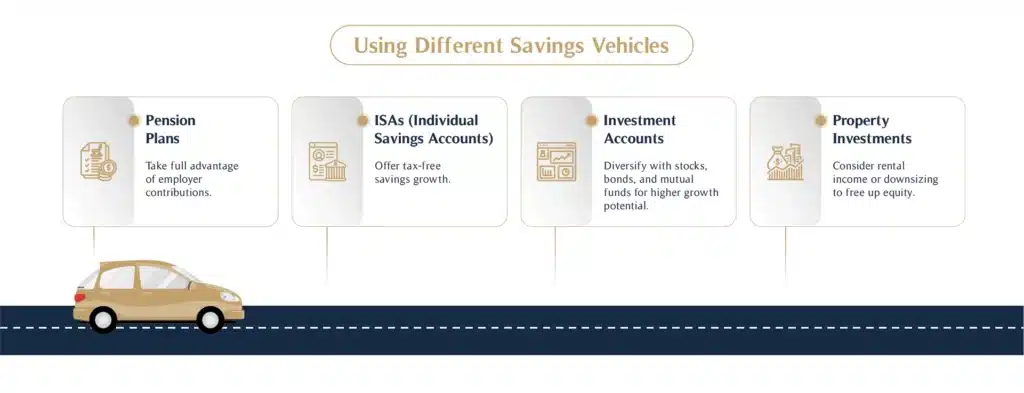Retirement is a life milestone that offers the opportunity to embrace new experiences, pursue hobbies, and enjoy well-earned rest. But to retire comfortably, financial preparation is key. Determining how much you need to save for retirement is a critical step that requires careful consideration of personal goals, lifestyle expectations, and financial resources.
In this guide, we’ll walk you through essential factors to consider when planning for retirement savings, provide actionable strategies, and empower you to take proactive steps toward securing your financial future.
How to Save to Retire: Understanding Your Retirement Needs
Before determining how much you need to save, it’s important to understand what your retirement might look like.
1. Define Retirement Goals and Lifestyle Expectations
Start by envisioning your ideal retirement.
- Will you travel extensively or settle into a quiet lifestyle?
- Do you plan to downsize your home or maintain your current standard of living?
- Are there significant expenses, such as supporting family members or pursuing higher education?
The answers to these questions will influence your savings requirements.
2. Estimate Annual Expenses During Retirement
A practical approach is to aim for 70–80% of your pre-retirement income to maintain a similar standard of living.
For example:
- If you earn £60,000 annually, plan for £42,000–£48,000 in retirement expenses per year.
Expenses to consider:
- Housing (rent, mortgage, maintenance)
- Utilities and daily living costs
- Leisure activities and travel
- Insurance premiums and healthcare.
3. Consider Healthcare Costs and Inflation
Healthcare often becomes a significant expense in retirement. Premiums, treatments, and long-term care can add up quickly. Also, inflation erodes purchasing power over time, so your retirement savings must account for rising costs.
- Tip: Plan for a 3–4% annual increase in expenses to counteract inflation.
How Much Do You Need to Retire: Calculating the Required Savings
1. The General Rule of Thumb
To determine how much to save, multiply your estimated annual expenses by 25. This “25x rule” is based on the 4% withdrawal rate, a widely recognised strategy to ensure your money lasts.
- Example: If you need £40,000 annually, your retirement savings target would be £1,000,000 (£40,000 x 25).
2. Factors Affecting the Amount Needed
Several variables can influence your target savings:
- Current Age and Retirement Age: The earlier you start saving, the more time your investments have to grow. If you plan to retire early, you’ll need more savings to support a longer retirement.
- Expected Lifespan: With people living longer, it’s prudent to plan for 20–30 years of retirement.
- Sources of Retirement Income: Consider income from pensions, rental properties, or other investments that may reduce your reliance on savings.
Smart Strategies to Save to Retire Comfortably
Achieving your retirement savings goal requires a strategic and disciplined approach.
1. Setting a Savings Target
Based on your calculations, set a clear and achievable savings target. Break it down into monthly or yearly contributions to make the goal less overwhelming.
2. Starting Early and Leveraging Compound Interest
The earlier you start saving, the more you benefit from compound interest, where your earnings generate additional earnings.
- Example: Saving £200/month from age 25 to 65 at a 6% annual return could grow to £400,000. Starting at age 35 would yield only £200,000.
3. Using Different Savings Vehicles
Maximise the potential of various retirement savings tools:
4. Regularly Reviewing and Adjusting Savings Plans
Life changes, such as promotions, unexpected expenses, or shifts in retirement goals, may require you to adjust your savings strategy. Regularly review your progress and rebalance your portfolio to ensure alignment with your objectives.
For more insights, read about Investing in Retirement.
Conclusion
Planning for retirement is one of the most important financial decisions you’ll make. By understanding your needs, setting realistic savings targets, and adopting disciplined strategies, you can build a future that aligns with your aspirations.
At MHG Wealth, our retirement planning service specialises in helping individuals and families plan for a comfortable and secure retirement. Our team of experts is here to provide personalised guidance tailored to your unique goals.
Start your retirement planning journey today. Contact MHG Wealth for professional advice that turns your dreams into a reality.






